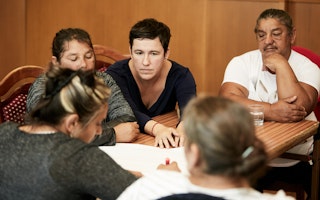The Roma Are Coming: Ed Kashi on the Misuse of Photography
By Will Cohen

Last week, the Swiss magazine Die Weltwoche established a new low in media coverage of European Roma. Alarmed by a supposed rise in crime in the country, Die Weltwoche opted to anchor its cover spread with a photo of a young Roma boy holding a gun, the nose of the barrel aimed at the reader. The headline, in German, warns Switzerland: "The Roma are Coming."
The cover spread, which is stark and shocking for its racism, has drawn an appropriately swift and angry response. The cover also represents a pretty flagrant editorial abuse of documentary photography. There's nothing to tell readers that the image actually dates from 2008 and has not even a distant connection to any development in Switzerland. The photograph, taken by the Italian photojournalist Livio Mancini, was originally part of a photo reportage done about a Roma community in Kosovo. Mancini photographed children playing in a local dump. The gun is actually a toy. Shorn of context, though, the once documentary photograph is deployed as propaganda.
I asked photojournalist Ed Kashi, who has photographed Roma communities and is working on a forthcoming project for the Open Society Foundations about ethnic profiling, for a photographer's perspective on the ethics of a situation like this.
Publishing photographs outside their original context happens all the time—magazines or newspaper choose one image from many to illustrate a story. But this seems an egregious misuse. Has something similar ever happened with your work?
The misuse of my images is something I am constantly on the lookout for, particularly when the work was originally made to have been seen in a specific context. Being a part of VII Photo, I am fortunate to have smart and concerned people watching out for misuse. The folks in my studio do the same. Unfortunately, even with this level of vigilance—and with all the hard work that goes into making sure every image includes meta data that preserve facts and context—there are still instances that slip through. One example, which really bothered me morally, happened in 2005. My stock agency at the time, Corbis, sold an image of a young Nigerian boy hanging off of an anti HIV/AIDS sign to the ultra-conservative organization Focus on the Family. It turned up in an anti-family planning campaign. While this misuse maybe isn't as damaging as using an image of a Roma kid with a toy gun on the cover of a consumer magazine, it points to the same issue of editors behaving responsibly and avoiding sensationalism.
Where does the responsibility for a misuse like this lie?
Provided the photographer and agency have properly contextualized their work, the responsibility for this misuse lies squarely on the shoulders of the editors who made the decision to use the image. This responsibility is very real. Images are very potent in today's media saturated world—they often supplant proper education in many places. Their misuse is serious. In extreme cases, it can cause violence and deaths, to say nothing of promoting misunderstanding, racism, and xenophobia.
Given the obvious power of images—and the dangers that come with it—how do photojournalists approach the ethics of working with vulnerable communities? What are the responsibilities of the photographer?
This is an important and challenging question. I know some photographers who do not distribute their archives through agencies exactly for this reason. There are others who demand that any sale of their work is first passed by them, even if it means they lose sales. Most photographers, though, employ a blind faith that the system of checks and balances will work and editors will make responsible and educated decisions. The responsibility of the photographer, at a minimum, is to accurately caption and keyword their work, and to include an explanatory text to give fuller and broader meaning to what the images represent.
Could you argue photographers shouldn't take that picture or shouldn't publish that picture, because of its potential to play into a situation just like this one?
I don't believe you should edit yourself in the field, except in extreme circumstances. But you need to be smart and aware about what's already been done, about what the implications of your images can be and how they might be misused. That way you can mitigate the potential for damage down the road. This is much harder for ambitious photographers who are trying to make a splash or name for themselves and might not always deploy the best ethics.
Laif, the agency that represents Livio Mancini, has posted a response to this situation on its web site. They write, "We live in a world that is more and more visual oriented. Therefore, we need visual ethics." I wonder what you make of that idea—"visual ethics." What would that mean for you?
I absolutely agree with Laif's comments. I know many of the folks at that agency and they are good, responsible and well-meaning visual communicators. We need to educate the public in media literacy, so they can make better judgments about what they see and read in the media and on the internet, we need hard core ethics within our profession to uphold the highest standards of responsible reporting and editing and we need to hold each other accountable on these most important issues.
The power of this image, in this context, is that it presents for some a confirmation of their worst fears about a particular minority group. You've photographed Roma communities. As you make pictures, are you thinking about how images do or don't play into stereotypes?
As recently as last year I was photographing Roma people in the French city of Marseille as part of a larger project for National Geographic. I came to learn how many of these families wanted to live in permanent housing, send their kids to school, receive health care, pay rent, and find decent employment. This completely flies in the face of the stereotypes that surround this community. That isn't to say there aren't Roma who use crime and begging to survive, but I found myself questioning the validity of my work and the purpose of the images I was seeking and making. What good would they do? How could I photograph this community in a different way to express another viewpoint and communicate a valuable new story? In the end, I am always looking to make evocative and meaningful images, so in the moment I'm not always thinking about the subsequent implications of what I'm creating. Which is why I think it's so important to know what you're reporting on. That way, afterwards, when you can review your work, you're able to contextualize it properly and edit in a way that avoids sensationalism and irresponsible usages of that work. That responsibility is all the greater when you're dealing with a vulnerable community.
Over the last 20 years, the Open Society Foundations have been committed to bringing about real change for Europe’s Roma: from creating the first ever Roma Pride Camp to fighting forced sterilization of Roma woman and segregation of Roma children into separate schools to advocating for better policies for Roma inclusion in the EU.
Until March 2014, Will Cohen was a senior communications officer with the Open Society Justice Initiative.


